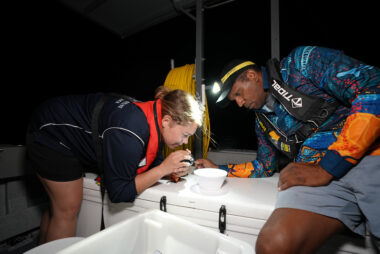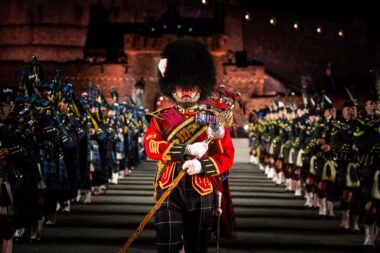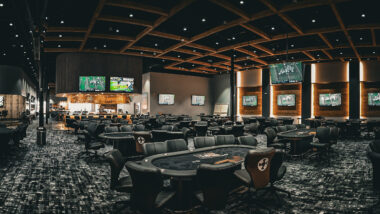Dozens of Science Week stories around South Australia
- See the giant ancient kangaroos, marsupial lions and rock formations of Naracoorte Caves without leaving home
- Dancing with diprotodons with the singing palaeontologist Professor Flint – Naracoorte
- Plants in space – Adelaide
- 3D Printing, VR, Robotics, Laser Cutting and more: City Library becomes an Innovation Lab
- Meet the scientists who speak for the trees – Adelaide
- Liquid nitrogen show with Nitro Nat – Blackwood
- How to grow a Martian garden – Roseworthy
- Treewilding - people’s relationships with forests - Tusmore
- Why a caterpillar needs ants to become a butterfly - Victor Harbor
- Can you see the stars? Dark skies versus light pollution
More on these highlights below.
Scientists, experts and event organisers are available for interview throughout National Science Week.
Read on for direct contact details for each event, or contact Tanya Ha – [email protected] or 0404 083 863.
Visit ScienceWeek.net.au/events to find more stories in your area.
Media centre here. Images for media here.
South Australia launch event and science awards TONIGHT at the Museum
National Science Week kicks off tonight at 6pm with the presentation of a swag of awards: the Citizen Science Award, the Unsung Hero Science Communication Award and the 2024 Young Tall Poppy Science Awards.
The event is presented by the National Science Week committee, Australian Institute of Policy and Science, SA Government Department for Environment and Water, and Australian Citizen Science Association (SA Chapter).
Launch event with:
- Her Excellency the Honourable Frances Adamson AC, Governor of South Australia
- Award winners.
Where: South Australian Museum, North Terrace, Adelaide 5000
Media enquiries: Jacqueline Stephens, [email protected] or 08 8201 3972
Event information: events.humanitix.com/2024-national-science-week-launch-and-awards-presentation
National Science Week in SA: highlights
Giant ancient kangaroos, Tasmanian tigers, and a singing palaeontologist – online, via Naracoorte
Naracoorte Caves is home to an exquisitely preserved giant wombat, a 2.5 metre kangaroo, marsupial lions, giant monitor lizards, Tasmanian tigers, and other megafauna fossils. It’s one of the largest and oldest fossil sites in the world, celebrating the 30th anniversary of its World Heritage listing this year.
Meet the megabeasts and the scientists who study them through webinars presenting the latest discoveries in the caves, livestreamed from within the caves themselves. Significant discoveries include finding new species of animals and understanding how mammals respond to climate change.
In addition, the singing palaeontologist Professor Flint will launch his new album ‘Dancing with Diprotodons!’
Featuring:
Beyond the Boundaries – opening event (Sunday 11 August): Meet the scientists, the locals, the fossils, and the singing palaeontologist Professor Flint.
Detectives in Time (Monday 12 August): exploring what palaeontologists do
Naracoorte's Megafauna Revealed (Monday 12 August): renowned palaeontology Dr Liz Reed shares her knowledge of Australia's extinct megafauna like the marsupial lion Thylacoleo carnifex and the largest marsupial known Diprotodon optatum.
Learn about the Southern Bent-wing (Tuesday 13 August): Southern Bent-wing Bat researcher Nicola Bail on this critically endangered species of bat
All about the 'Tites and 'Mites (Tuesday 13 August): learn more about speleothems, such as flowstone, columns, drapery, stalagmites, stalactites and straws.
History of the Naracoorte Caves (Wednesday 14 August): Learn about early scientific discoveries and developments in the caves, from early research by Julian Tenison-Woods, historical uses of the caves post-European colonisation, and development by early park managers and the eventual discovery of significant fossil deposits in Victoria Fossil Cave.
Beyond the Boundaries – Geology of the Naracoorte Caves (Wednesday 14 August): geologist Ian Lewis takes a trip back in time to when the Naracoorte Caves didn't exist.
Media enquiries: Thoman Shortt, [email protected]
For Professor Flint: Michael Mills, [email protected] or 0411 287 381.
Singing dinosaurs and dancing diprotodons – Naracoorte
If Australian megafauna still roamed the Naracoorte Caves, do you think they’d dance to music? Get your bones moving with Professor Flint in a musical celebration of all things prehistoric with songs and dance at a special album launch inside Blanche Cave.
Prof Flint will lead kids and families on a musical journey to discover the remarkable fossil heritage of the Caves, sharing the stories of Naracoorte's prehistoric past. Unable to get to Naracoorte? Not a worry as the event will also be streamed online.
Sunday 11 August. Event details: www.scienceweek.net.au/event/dancing-with-diprotodons/naracoorte
Media enquiries: Michael Mills, [email protected] or 0411 287 381.
Professor Flint (aka Michael Mills) is available for media interviews.
Plants in space - Adelaide
What do we need for plants to thrive off-Earth? How can we produce enough food for the astronauts in this new environment and encourage sustainability?
Join us in a craft activity to explore how and why we grow things in space. Think about how our own designs could help future generations use and enjoy plants in space.
As humans continue to explore space and go on longer missions, to the Moon and further to Mars, plants will come along with us. Astronauts have been nurturing space gardens on the International Space Station for decades, but we are still finding the best ways to grow plants in space. Plants in space are used for food and research, but they are also playing an important role for astronauts’ well-being and foster a connection to Earth.
Sunday 11 and Sunday 18 August. Event details: https://www.scienceweek.net.au/event/operation-plants-in-space/adelaide
Media enquiries: Australian Space Discovery Centre, [email protected] or 08 8432 1400.
3D Printing, VR, Robotics, Laser Cutting and more: City Library becomes an Innovation Lab - Adelaide
Come experiment and explore cutting-edge technologies including 3D printers, robotics, virtual reality, laser cutter and more.
The Innovation Lab team supports thousands of people who invent, create and discover for free through workshops and activities at the Adelaide City Library.
Personalised booked sessions and drop-ins are available at set times. Activities include:
- Virtual Reality (VR): a mind-blowing journey without leaving the library!
- Discover Robotics: Get hands on with a variety of robots to run a maze, do some block coding or even make a robot dance.
- 3D Printing: 1.5-hour hands-on sessions with 3D printing, modelling, scanning, or 3Doodler pens.
- Laser Cutter: Swing by a drop-in information session at the Innovation Lab to find out what this technology can do.
Thursday 1 - Saturday 31 August. Event details: www.scienceweek.net.au/event/innovation-lab-3d-printing-vr-robotics-laser-cutting-holograms/adelaide
Media enquiries: Matt Halliwell, [email protected] or 0411 155 061.
Meet the scientists who speak for the trees – Adelaide
Imagine the stories and insight a 300-year-old tree could share if they could speak. What might they say that could impact the way we approach climate, food or urban sustainability?
Meet the local researchers giving the trees a voice using the best scientific tools and plant ecophysiology to understand their past and envision their future.
Featuring:
- Dr Samuel Holt, LiDAR Product Manager at Aerometrex, specializing in geospatial data for land management and climate resilience
- Assoc. Professor Beth Loveys, University of Adelaide, focusing on plant ecophysiology and the impact of climate change on plant growth
- Dr Kate Delaporte, Curator of the Waite Arboretum, with expertise in the Urban Forest and Australian native plants.
Thursday 15 August. Event details: www.scienceweek.net.au/event/q-can-we-innovate-creativity-2/adelaide
Media enquiries: Dylan DeLosAngeles, [email protected], 08 8302 4072
Supreme States of Matter Liquid Nitrogen Show with Nitro Nat - Blackwood
Using liquid nitrogen, discover how cooling different materials changes them.
Discover the wonders of liquid nitrogen with science communicator Nitro Nat.
She will take you on a journey to discover how cooling different materials changes them. Using liquid nitrogen, you’ll explore solids, liquids, gases and plasma (in the form of fire). Discover what happens when lettuce meets liquid nitrogen. Smash, crush and create a salad using a super cool (literally) liquid.
Saturday 17 August. Event details: www.scienceweek.net.au/event/supreme-states-of-matter-liquid-nitrogen-show-with-nitro-nat/blackwood
Media enquiries: Mitcham Library, [email protected] or Nitro Nat, [email protected].
Treewilding - people’s relationships with forests - Tusmore
Is replanting trees anywhere going to restore landscapes after harvesting forests – or does it take more thought than that? Join microbial and restoration ecologist and popular science writer, Dr. Jake M Robinson, to learn why forest restoration is so challenging and where Western science and Indigenous knowledge might, together, provide solutions.
Dr. Robinson is the author of two books, Invisible Friends, about microbes and their role in shaping the modern world, and Treewilding - Our Past, Present and Future Relationship with Forests, about human relationships with forests. His talk will introduce Treewildling and reveal why forests are more than the wood that makes them.
Saturday 17 August. Event details: www.scienceweek.net.au/event/treewilding-our-past-present-and-future-relationship-with-forests-dr-jake-m-robinson/tusmore
Media enquiries: Sarah Roberts, Burnside Library, [email protected] or Jake M Robinson, [email protected].
How to grow a Martian garden – Roseworthy
Could you live in a Martian garden? Over the next 30 years, human missions to the moon and Mars are planned: but can these extreme environments provide habitat for humans?
Five events across South Australia, Victoria, and Western Australia will invite the public to explore these challenges and try their hand at life beyond Earth in ‘The Martian Garden’.
Hear from ARC Centre of Excellence in Plants for Space researchers about selecting and adapting plant and microbial species to survive and thrive in new and extreme environments, how to support sustainable new ecosystems off-world, and how to find novel approaches back on Earth.
Sunday 18 August. Event details: www.scienceweek.net.au/event/the-martian-garden/roseworthy/
Media enquiries: Lieke van der Hulst, [email protected] or 08 8313 6669; Frazer Thorpe, [email protected] or 0459 762 299.
Scientists Jenny Mortimer and Christine Feinle-Bisset are available for media interviews.
The Roseworthy location will include demonstrations of Mars Rovers at the Exterres Analogue Facility, which could provide interesting visual opportunities.
Why a caterpillar needs ants to become a Chequered Copper butterfly - Victor Harbor
Butterflies are beautiful AND important for the environment.
Join us independent artist Rosina, and Gerry from Butterfly Conservation South Australia for a virtual reality (VR) experience all about attracting butterflies to your garden, how important they (and other insects) are in our environment.
The presentation will also focus on the mutual symbiosis of the Chequered Copper butterfly. As a caterpillar this animal is herded by ants to their host plant food and then into the ant nest to shelter from predators. The adult butterfly emerges from the chrysalis in the ant nest and crawls up the ant-hole to fly away and find a mate.
This experience has been translated into a theatrical play, then digitised and available for view on Virtual Reality (VR) headsets during the session.
Friday 16 August. Event details: www.scienceweek.net.au/event/herding-caterpillars-with-butterfly-conservation-sa/victor-harbor
Media enquiries: Butterfly Conservation SA, [email protected] or 08 8297 8230
Why can’t you see the stars? – online
What happened to the night sky? The Milky Way is no longer visible to an estimated third of humanity, including more than half of Australians, thanks to light pollution.
This August, the ABC is exploring the dark sky and the impact of light pollution on science, creatures, and culture. Light pollution in the night sky is a problem for astronomers and stargazers, it confuses the circadian rhythms of some creatures and misguides the navigation of others, impacts Sky Country and Indigenous cultural practices, and contributes to sleep deprivation in humans.
ABC Science will invite people to explore the dark sky, contribute to an Australian National University study of the Milky Way’s visibility, see solutions to light pollution, stargaze with Radio National and guest astronomers, and vote in their poll on ‘the most amazing thing you’ve seen in the night sky.’
Monday 31 July – Friday 16 August: www.scienceweek.net.au/exploring-dark-skies-with-abc/ or www.abc.net.au/nightsky.
Media enquiries: Shelley Thomas, [email protected] or 0416 377 444.
Scientists available for media interviews, including Dr Sheryn Pitman who is the project lead for Australia’s first International Dark Sky Community, in Carrickalinga, SA.
About National Science Week
National Science Week is Australia’s annual opportunity to meet scientists, discuss hot topics, do science and celebrate its cultural and economic impact on society – from art to astrophysics, chemistry to climate change, and forensics to future food.
First held in 1997, National Science Week has become one of Australia’s largest festivals. Last year about 2.7 million people participated in more than 1,860 events and activities.
The festival is proudly supported by the Australian Government, CSIRO, the Australian Science Teachers Association, and the ABC.
In 2024 it runs from Saturday 10 to Sunday 18 August. Event details can be found at www.scienceweek.net.au.



